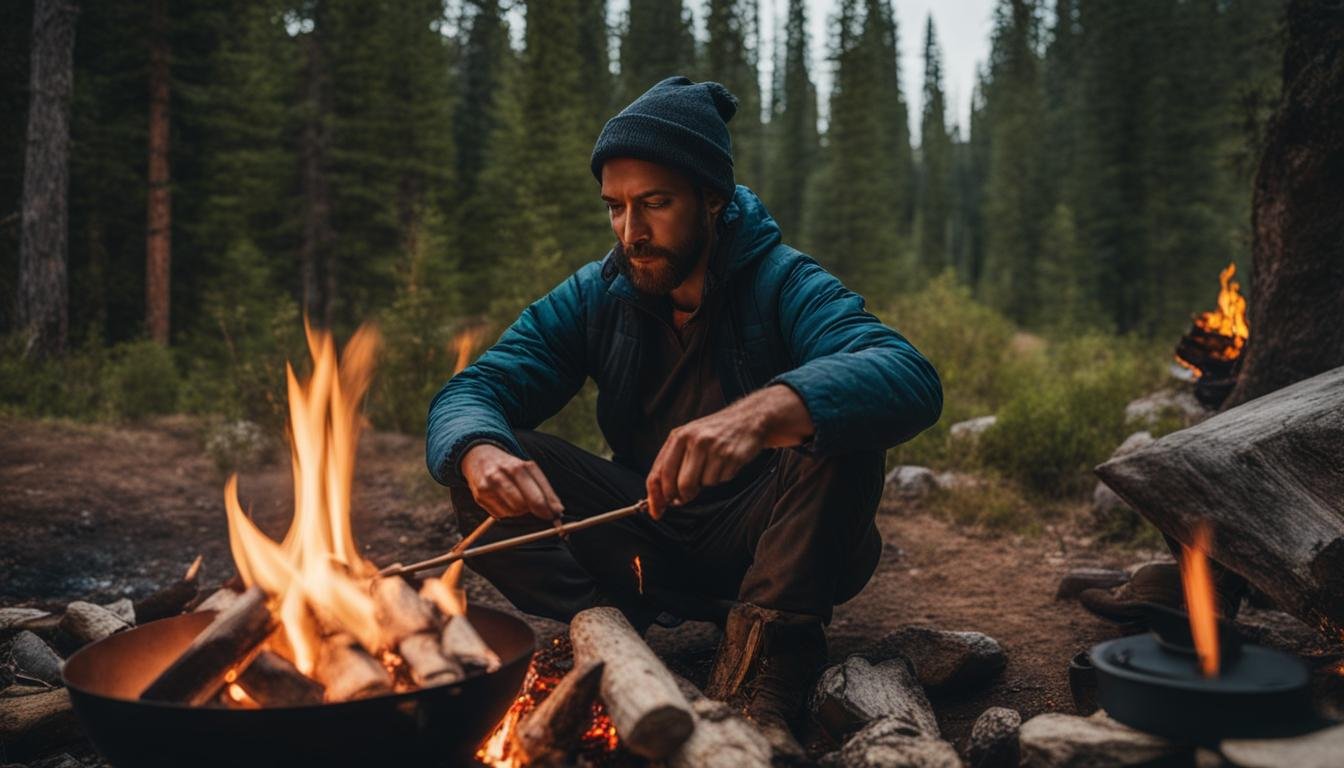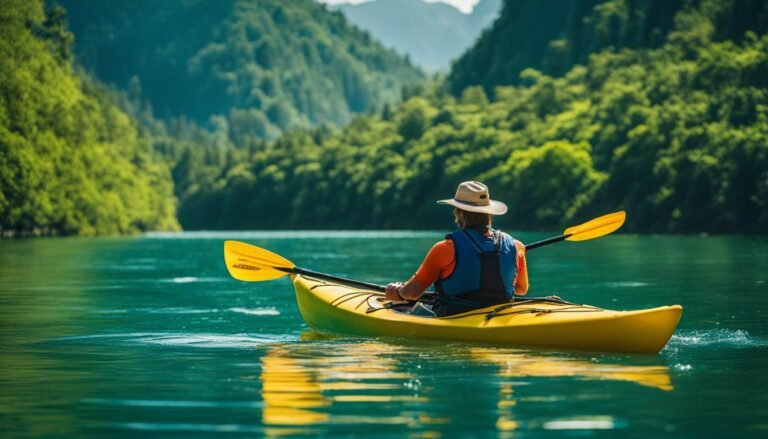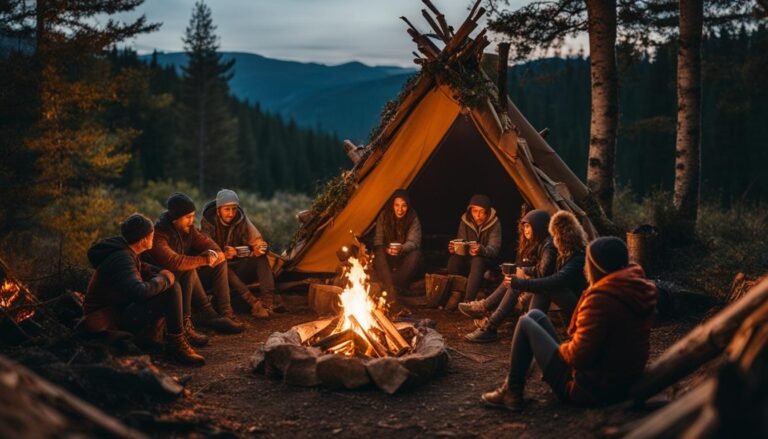20 Outdoor Survival Skills (For Added Fun)
Outdoor survival skills are essential knowledge and abilities that can mean the difference between life and death in a wilderness or emergency situation.
20 Outdoor Survival Skills
While the specific skills required may vary depending on the environment and circumstances, here is a comprehensive list of some of the most important outdoor survival skills:
Shelter Building
In a wilderness survival situation, your first priority is often shelter. Exposure to the elements can lead to hypothermia or other serious health issues, so creating a suitable shelter is crucial.
Here are some important aspects to consider:
- Materials: Look for natural materials in your environment, such as sturdy branches, leaves, and debris like dry grass, moss, or pine needles.
- Shelter Types: There are various shelter designs to choose from based on your environment and available resources. Common options include:
- Lean-to: This is a simple shelter made by propping a large, flat object like a piece of wood or a tarp against a support, such as a tree. It provides a basic windbreak.
- Debris Hut: This shelter involves creating a framework from branches and then covering it with leaves, grass, or other insulating materials to keep you warm.
- A-Frame Shelter: This type of shelter resembles an ‘A’ and is constructed with two inclined supports and a horizontal ridge pole. It provides more protection against rain and wind than a lean-to.
- Sturdiness: Ensure your shelter is well-constructed and can withstand the elements. Test it for stability and reinforce weak points.
- Insulation: To stay warm, add insulating materials like leaves, pine boughs, or clothing inside your shelter. This will help trap body heat.
- Protection: Make sure your shelter protects you from wind, rain, and cold ground. If you have a fire, position your shelter so that smoke can escape without filling it.
Fire Starting
Fire is not only essential for warmth but also for cooking food and purifying water. Here’s how to start a fire effectively:
- Methods: There are various fire-starting methods to learn, including:
- Friction Methods: These involve creating fire through the friction of two pieces of wood, like a fire bow or fire plow. This method requires practice and skill.
- Flint and Steel: Modern tools like flint and steel or ferrocerium rods create sparks when struck against steel, which can ignite tinder.
- Tinder and Kindling: Gather dry, fine materials like dry leaves, bark, or cotton balls as tinder. Collect small sticks and twigs as kindling to feed the initial flames.
- Fire-Building Techniques: Learn different fire-building techniques, such as the teepee (arranging to kindle in a cone shape), log cabin (stacking larger sticks in a square around a central tinder bundle), or lean-to (placing the kindling against a larger fuel source).
- Sustainability: Be mindful of your fire’s impact on the environment. Keep fires small and use only dead and downed wood to minimize damage to living trees.
Water Procurement and Purification
Clean water is essential for survival, but water sources in the wild can be contaminated. Here’s how to ensure safe water:
- Finding Water: Look for natural water sources like streams, rivers, or lakes. If those are unavailable, you can collect rainwater or dew using improvised containers.
- Purification: Always purify water to remove harmful microorganisms. You can do this by:
- Boiling: Boil water for at least one minute (or longer at higher altitudes) to kill pathogens.
- Chemical Treatment: Use water purification tablets or drops to disinfect water. Follow the manufacturer’s instructions.
- Portable Filters: Carry a portable water filter to remove impurities and pathogens.
- Solar Still: In a survival situation, you can create a solar still to collect condensed water from the ground.
- Storage: Store purified water in a clean container to prevent recontamination.
Navigation
Navigating in the wilderness is all about finding your way when there are no familiar landmarks or roads. Here’s what you need to know:
- Reading Maps: Familiarize yourself with topographic maps. These maps show elevation contours, water features, and terrain details. Learn to read contour lines to understand the landscape’s shape and elevation changes.
- Using a Compass: A compass is a valuable tool for finding direction. The needle points north, helping you orient your map and yourself. Combine compass use with map reading to follow a route or find your way to safety.
- Terrain Features: Pay attention to the terrain around you. Look for distinctive features like hills, valleys, ridges, and prominent landmarks. These can help you stay on course and pinpoint your location on a map.
- Celestial Navigation: In the absence of a compass or map, you can use celestial objects like the North Star (Polaris) to determine direction. Polaris is almost directly north and can serve as a reliable reference point at night.
Wilderness First Aid
Being prepared to provide basic first aid in the wilderness can be a lifesaver. Here’s what you should know:
- Wound Care: Learn how to clean wounds with clean water, disinfect them, and dress them with sterile bandages. Keep wounds covered to prevent infection.
- Fracture Management: If someone has a suspected fracture, immobilize the injured limb using materials like clothing, sticks, or a splint from your survival kit. This prevents further damage and eases pain during transport.
- Hypothermia: Recognize the signs of hypothermia, which include shivering, confusion, and slowed movements. Warm the person gradually, using clothing, shelter, and heat packs if available.
- Heatstroke: In hot environments, watch for heatstroke symptoms such as confusion, rapid pulse, and hot, dry skin. Cool the person down by providing shade, water, and wet clothing.
Food Foraging and Hunting
Knowing how to find food in the wild is essential for long-term survival. Here’s what you should keep in mind:
- Edible Plants: Familiarize yourself with local edible plants. Learn to positively identify species like dandelions, cattails, and wild berries. Be cautious; some plants can be toxic.
- Insects: Insects like grasshoppers, ants, and larvae are excellent sources of protein. They are often easier to catch than larger game.
- Traps and Snares: Learn to create simple traps and snares for catching small game. Practice setting them and checking them regularly. Be sure to research local regulations, as some trapping methods may be illegal.
- Safety: Always prioritize safety and ethical foraging. Don’t eat anything you’re not sure about, and respect the environment by minimizing your impact on the ecosystem.
Knife Skills
A reliable knife is a wilderness multi-tool. Here’s how to make the most of it:
- Safe Handling: Always handle your knife with care. Cut away from your body and keep your fingers clear of the blade. A sharp knife is safer than a dull one.
- Cutting and Carving: Learn how to cut, carve, and shape materials like wood for shelter building, firecraft, or tool making. A knife can also be used to prepare food.
- Self-Defense: While it’s not the primary purpose, a knife can serve as a self-defense tool in extreme situations. Learn basic self-defense techniques, but remember that avoidance and de-escalation are often safer options.
- Maintenance: Keep your knife sharp by regularly honing and sharpening it. A sharp blade is more effective and safer than a dull one. Clean and dry your knife after use to prevent corrosion.
Signal and Communication
Signaling for rescue is vital if you find yourself in a survival situation:
- Visual Signals: Use a mirror to reflect sunlight or a flashlight to signal for help. Aim the beam at aircraft or search parties. In emergencies, even a simple signal fire with wet leaves can produce noticeable smoke during the day.
- Auditory Signals: Carry a whistle to create loud, distinctive sounds that can carry over long distances. Blowing three short blasts is often recognized as a distress signal.
- Emergency Communication Devices: Whenever possible, carry emergency communication devices like radios or satellite phones. These can help you contact rescuers directly.
Weather Awareness
Understanding the weather can prevent exposure and hypothermia. Here’s what to look for:
- Cloud Patterns: Darkening, thickening clouds can indicate an approaching storm. A clear sky at night may indicate cold temperatures.
- Wind Direction: Notice the direction of the wind; it can help you anticipate weather changes and choose shelter locations.
- Air Pressure: A rapid drop in air pressure can be a sign of approaching bad weather. A barometer can provide a numerical reading of air pressure changes.
Knot Tying
Knots are indispensable in survival scenarios:
- Square Knot: This knot is useful for joining two ropes of similar size securely.
- Bowline: The bowline creates a secure loop that won’t slip or jam, making it great for rescue operations or securing a line to a fixed object.
- Taut-Line Hitch: This adjustable knot is excellent for securing tent guy lines or adjusting the tension on a rope.
Improvisation
In survival situations, creativity is your ally:
- Tool Making: Learn to fashion tools from natural materials. For instance, craft a fishing spear from a sturdy branch or carve a digging stick for foraging.
- Shelter Construction: Build shelters using the resources available. Even a lean-to made from branches can offer protection from the elements.
Psychological Resilience
Staying mentally strong is key to survival:
- Positive Mindset: Maintain a positive attitude. Focus on small victories and stay hopeful.
- Stress Management: Practice relaxation techniques like deep breathing to manage stress and anxiety.
- Task Focus: Stay focused on the immediate tasks at hand. Survival often involves a series of small, manageable steps.
Animal and Insect Awareness
Understanding how to coexist with wildlife and insects is vital:
- Avoiding Encounters: Make noise while hiking to alert animals to your presence, reducing the likelihood of startling them. Keep food and trash sealed to avoid attracting wildlife to your campsite.
- Dealing with Encounters: If you encounter potentially dangerous animals like bears or big cats, don’t run. Instead, back away slowly while speaking in a calm, assertive voice. Insect repellent and proper clothing can help protect against insect bites.
Leave No Trace
Practicing Leave No Trace principles is essential for preserving the wilderness for future generations:
- Dispose of Waste: Use established restrooms or dig a cat hole for human waste, and pack out all trash, including food scraps.
- Campsite Selection: Choose established campsites when possible to minimize impact. Follow the principle of “campfire leave no trace” by using a camp stove instead of making open fires.
- Respect Wildlife: Observe wildlife from a distance and avoid approaching or feeding them.
- Stay on Trails: Stick to established trails to avoid trampling fragile vegetation and disturbing wildlife habitats.
Teamwork and Leadership
In group survival situations, teamwork can be your greatest asset:
- Assign Roles: Based on each member’s strengths and skills, assign roles such as firekeeper, navigator, and forager.
- Effective Communication: Maintain clear communication to coordinate efforts and share critical information.
- Support and Encouragement: Keep morale high by offering encouragement and support to one another. A positive atmosphere can boost spirits during tough times.
Situational Awareness
Staying alert to your surroundings can help you avoid hazards:
- Potential Dangers: Recognize potential threats like unstable terrain, weather changes, or approaching wildlife.
- Assess Risks: Evaluate risks before taking action. Is it safe to cross that river? Should you take shelter due to worsening weather conditions?
- Adaptability: Be flexible and willing to adjust your plans in response to changing circumstances.
- Stay Calm: In high-stress situations, maintaining composure is crucial. Panic can lead to poor decision-making.
Resource Management
Effectively managing your resources is key to long-term survival:
- Rationing: Conserve your food and water by rationing them. Establish a daily intake plan to ensure your supplies last as long as possible.
- Prioritization: Prioritize your resources based on necessity. Water takes precedence, followed by food and shelter. Use energy wisely; avoid unnecessary physical exertion.
- Sustainability: When foraging for food, gather what you need without depleting the environment. Only take what you can consume, and avoid wastage.
Cold Weather and Heat Management
Understanding how to cope with extreme temperatures is crucial:
- Cold Weather: In cold climates, dress in layers to trap heat close to your body. Use insulating materials like wool and avoid sweating excessively, as wet clothing can lead to hypothermia.
- Heat Management: In hot environments, wear lightweight, breathable clothing and use hats and sunscreen to protect against sunburn. Stay hydrated and take breaks in the shade to prevent heat-related illnesses like heatstroke.
Water Crossing
Crossing rivers and streams safely is a skill you should master:
- Assess the Water: First, assess the depth, speed, and strength of the current. It’s often best to avoid crossing if the conditions are hazardous.
- Use a Staff: If you decide to cross, use a sturdy staff or stick for stability. Cross at a diagonal angle downstream, which reduces the force of the current.
- Buddy System: Whenever possible, cross with a buddy. Linked arms or holding onto each other can provide mutual support.
Self-Defense
Basic self-defense skills are valuable in wilderness survival:
- Avoidance: Whenever possible, avoid potentially dangerous encounters with both wildlife and other humans. Make noise to alert animals to your presence, and choose your campsites wisely.
- Protective Measures: Carry deterrents like bear spray for wildlife encounters and learn to use them effectively. For self-defense against humans, focus on avoidance and escape rather than confrontation.
- Group Safety: In group scenarios, stay close to your team for mutual protection. Work together to create a secure environment.
While this list covers a wide range of outdoor survival skills, it’s important to remember that practice and real-world experience are key to mastering these abilities.
By mastering these skills, you not only increase your chances of surviving in challenging outdoor situations but also enhance your overall safety and well-being in the wilderness.
Regular training, education, and preparation can significantly enhance your chances of survival in challenging outdoor situations.







